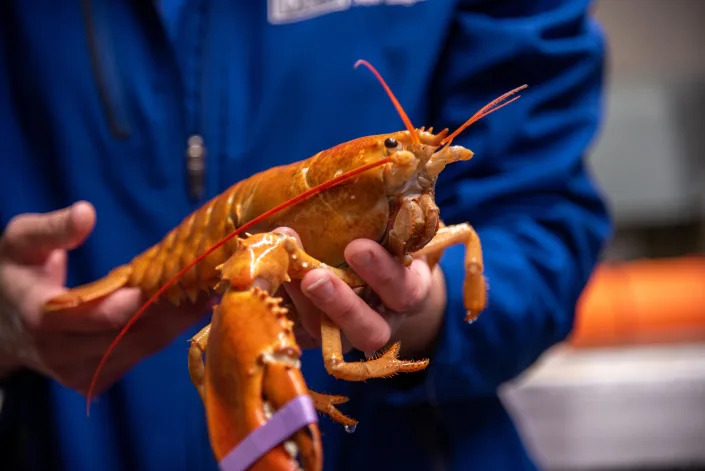Experts say that an orange lobster caught in Casco Bay, Maine on Friday by Capt. Gregg Turner and his crew, Sage Blake and Mandy Cyr, is a “one-in-30 million” find.
Researchers at the University of New England welcomed its latest addition – an orange lobster – to its collection of rare, multicolored crustaceans Monday, university officials announced. The unusually colored lobster is a one-in-30 million find, the university said.

The bright orange lobster was caught in Casco Bay, Maine on Friday by Capt. Gregg Turner and his crew, Sage Blake and Mandy Cyr.
Cyr announced the find on Instagram Saturday.
“My [c]aptain says he’s only seen 2 in his lifetime and the first time no-one [believed] him,” the post read.
Lobsters are typically a dull color when alive and only get their signature red hue after being cooked. Genetics influence lobster shell coloration, which is where multi-colored crustaceans get their unusual colors. The interplay of several different protection can also cause the lobster’s coloration, Markus Frederich, a Professor of Marine Sciences at the University of New England told CBS News. The lack of a certain gene, and then the respective protein, can lead to different colors, he said.
“These mutations that silence the respective genes are rare,” Frederich said.
Charles Tilburg, the director of the Arthur P. Girard Marine Science Center, told CBS News that researchers are also interested in whether environment or diet contributes to coloration.
“Will she consistently stay the same color between molts because of her particular genetic make-up or will she slowly change with each molt due to the new environmental conditions?” he asked.
The still-unnamed lobster also offers a unique opportunity for academics and students to study how a lobster grows its new claw in real-time.
“Also unique about this orange lobster, other than her incredibly rare coloration, is that she is missing a claw,” Alan Bennett, a public relations strategist at the university, added. “So faculty and students have a rare opportunity to study how her claw will regrow in real-time.”
Lobsters grow through molting — a process in which they struggle out of their old shells while simultaneously absorbing water which expands their body size, according to the University of Maine.
The lobster in question will start regrowing her missing claw before her next molt. However, it will take several molts to regrow a claw that’s proportional to the rest of her body.
“The claw regeneration happens surprisingly fast,” Frederich, the marine science professor, said. “As we have seen with Banana, our yellow lobster that arrived without any front claws, within 2 to 3 molts the claws regrow into their original size.”
An incredible incident happened in the village of Gorkha, located in Tehsil Begumganj of Raisen district in Madhya Pradesh, where a cow gave birth to a lion-like calf.



One Response
I just got $30,850 from my last month of work doing this online part time. j43 I joined 4 months ago and I know how easy it is to get paid for this job.
Register now via the website below. Click on………. http://workings11.blogspot.com